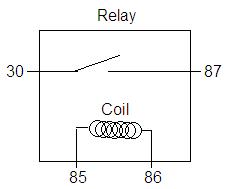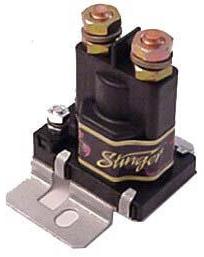|
Relays
Why use a Relay instead of a Switch
to power your hydrogen Generator On and Off? A lot of people have problems understanding why they need a
relay to control the On/Off of their hydrogen generator, and how a relay
works.
A switch rated at 20 amps can handle up to
20 amps, without over heating. If this switch is on your cars Dashboard,
that means the wiring for the switch is behind the dash. If your Battery
Voltage is wired to the switch, and the switch is wired to your Hydrogen
Generator, that means all of the electrical current (amps) is traveling
through the back of your Dashboard. If you make a mistake in choosing the
correct wire size to carry the amperage your cell is using, or you
choose a switch too small to carry the amperage your cell is using, or
you make a mistake and add too much Electrolyte to your cell, the
amperage will cause heat -- and the heat can cause damage behind the
dash. Your wiring could melt, and you would not know it until it was too
late. It is very hard to put a fire out - behind the dashboard. Even if
there is no fire, the heat can melt other wiring. So it is just not a
good idea to send that much amperage through a switch on your Dashboard.
A safer method is to use a Relay. Put it in
the engine compartment. Run your battery voltage to the relay, and come
out of the relay and go to the Cell. Then you can use a smaller switch
to turn the Relay On and Off. Cars have many relays; relays for
Horns, Headlights, Fuel Pumps, Turn Signals, and many other electrical
components that draw a lot of amperage from the battery supply. One way
or another, these relays are controlled by the Ignition switch. The
Ignition Switch is not capable of handling all of that electrical
amperage, but it is capable of switching multiple electronics.
|

- Terminal 30 is for your 12 volt positive from your battery
- Terminal 87 is for your 12 volt positive output to your cell
- Terminals 30 and 87 make contact when the relay gets turned on by 85
and 86
Wire an ignition switch circuit to Terminal 85, and wire 86 to chassis
ground.
When you turn on your ignition switch, it puts 12 volts on terminal 85 and
creates a magnetic field across the coil. The magnetic field pulls contacts
30 and 87 together. That in turn connects the battery with the cell.
The terminals of these
relays are defined as follows:
- 30 is the common or
input voltage to be switched.
- 87 is the normally
open connection (switched voltage output only when the relay is
energized).
- 86 is connected to
the ground of the triggering voltage.
- 85 is connected to
the positive 12V of the triggering voltage.
Note: in many cases,
the connection of pins 85 and 86 can be interchangeable, but NOT if there
is a diode wired across the coil.
A
wiring harness makes it easy to just plug in your relays and wire up the
wires to whatever you need. It includes all 5, color-coded wires to hook to
each of the relay's terminals. You can remove the wires and pins you don't
need with the blade of a small screwdriver.
|

 |
30/40 Amp Relay and Harness.
 "WiringProducts.com
(Automotive Relays & Harness) 30-200 amps "WiringProducts.com
(Automotive Relays & Harness) 30-200 amps
 Available from "The Robot Market Place"
Available from "The Robot Market Place"
These parts are available at many Auto Supply Stores. They are very
reliable relays, and easy to wire if you use the harness.
The purpose of the relay is to activate your cell when you turn on your
ignition.
|
 |
80 Amp Relay,
(very reliable)
Your Relay is used to connect your
battery voltage to the cell. It needs to be capable of handling all of the
amperage your cell uses, and then some.
- High Current Relays
are the most reliable and efficient way to turn on your HHO Cell
- Compatible with all
types of alternators and charging systems
- Wire it to your ignition switch.
- Water Resistant
black phenolic plastic
- 100,000 Mechanical
Cycle Life
 Available from
EBay seller bag-boy Available from
EBay seller bag-boy
 Available from
EBay seller audio-adapters Available from
EBay seller audio-adapters
|